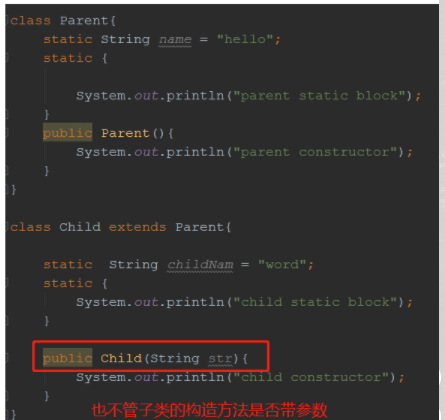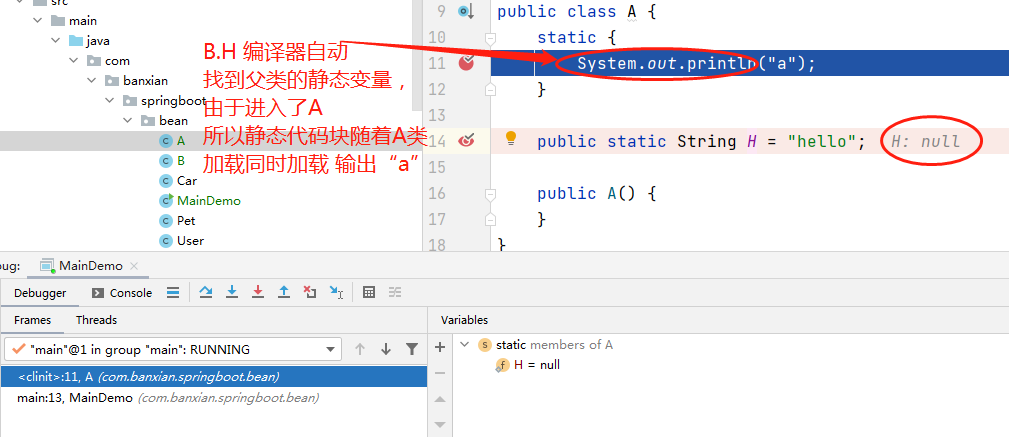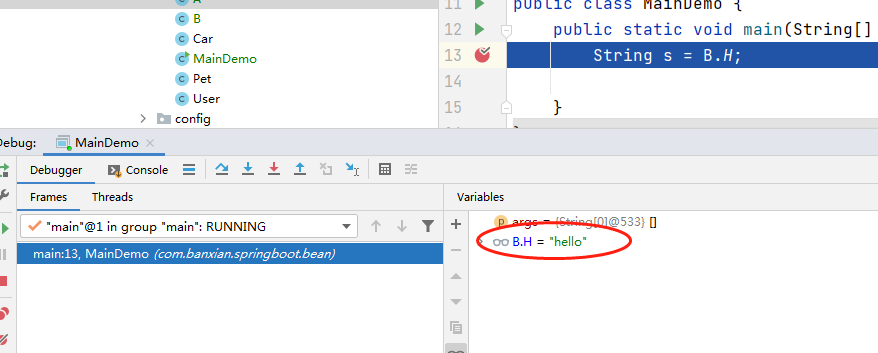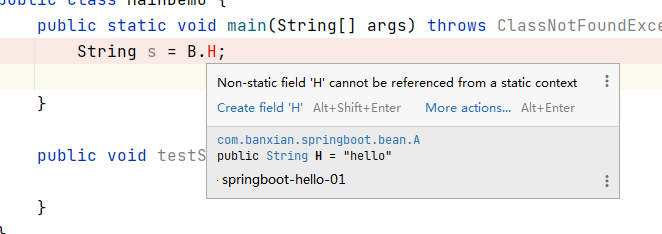问题1:
public class Demo01_StaticTest {
private static Demo01_StaticTest st = new Demo01_StaticTest();
public static int count1;
public static int count2 = 0;
private Demo01_StaticTest(){
count1++;
count2++;
}
public static Demo01_StaticTest getInstance(){
return st;
}
public static void main(String[] args) {
Demo01_StaticTest st = Demo01_StaticTest.getInstance();
System.out.println("count1: " + st.count1);
System.out.println("count2: " + st.count2);
}
}
2.分析
- 从
main方法中的顺序开始分析
Demo01_StaticTest st = Demo01_StaticTest.getInstance(); 这是一个静态方法,返回值是当前类中新定义的实例对象, private static Demo01_StaticTest st = new Demo01_StaticTest(); 执行顺序先执行无参构造方法 private Demo——StaticTest() { count1++; count2++; } 构造函数执行 count1/2初始值都是0 ,自增后都+1 此时count1 = 1,count2= 1; 构造函数外,除count1 无引用之外,count2重新引用指向0. 也就是方法参数的几个条件: 1 一个方法不能改变一个基本数据类型的参数 2 一个方法可以改变一个对象的参数状态 3 一个方法不能让对象参数引用一个新对象Demo01_StaticTest st = Demo01_StaticTest.getInstance();
执行到这 返回的count1 count2 为1 , 0;
-
3.问题变化
public class Demo02_StaticTest { public static int count1; public static int count2 = 0; private static Demo02_StaticTest st = new Demo02_StaticTest(); private Demo02_StaticTest(){ count1++; count2++; } public static Demo02_StaticTest getInstance(){ return st; } public static void main(String[] args) { Demo02_StaticTest st = Demo02_StaticTest.getInstance(); System.out.println("count1: " + st.count1); System.out.println("count2: " + st.count2); } }4.分析
- 完全一样的分析方法
- 最后的值为
1,1二、例2:父类子类中均有静态代码块
public class Demo03_StaticTest { public static void main(String[] args) { new Child();//请问会输出些什么,以及顺序 } } class Parent{ static String name = "hello"; static { System.out.println("parent static block"); } public Parent(){ System.out.println("parent constructor"); } } class Child extends Parent{ static String childNam = "word"; static { System.out.println("child static block"); } public Child(){ System.out.println("child constructor"); } }2.分析
- 在创建子类`new Child()的时候,会按下述的顺序执行
- 首先去父类中看是否用静态相关的东西,有就先执行
- 然后再看子类中是否用静态相关的东西,有就执行(以上两步可以总结为静态先行)
- 然后再去执行父类的构造函数
- 最后再执行子类的构造函数
- 所以最后的输出是:

3另一个重要的问题
-
当子类定义构造方法的时候,它首先会去找父类中不带参数的构造方法
-
所以父类中不带参数的构造方法永远先执行


-

- 这里有个问题,为什么必须要先执行父类的构造方法呢?
-
可以简单的理解,没有父类哪来的子类呢!
问题5:
public class A {
static {
System.out.println("a");
}
public static String H = "hello";
public A() {
}
}
public class B extends A {
static {
System.out.println("B");
}
}
public class MainDemo {
public static void main(String[] args) throws ClassNotFoundException {
String s = B.H;
}
}
分析:
这里很容容易思维定式:认为B.H;是新建了B对象 从而就父类静态代码块 子类静态代码块 父类构造方法 子类构造方法


这里并没有涉及到B类的实例化,因为静态变量在类之间是共享的,前提是需要在静态方法中调用 非静态可以使用静态,静态不能使用非静态
